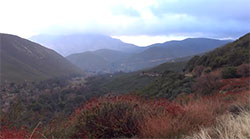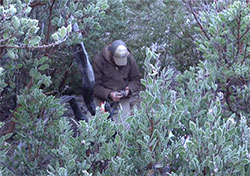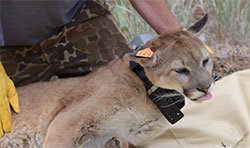CDFW wildlife biologist Justin Dellinger has a most unusual job -- since 2015, he’s been capturing and collaring mountain lions in California’s back country. Justin aims to achieve something unique, which is the first-of-its-kind comprehensive population assessment of California’s mountain lions.

Mountain lion territory, San Diego County.

Justin Dellinger in the field, for the mountain lion study.

Mountain Lion after capture, before being released.
CDFW wildlife biologist Justin Dellinger has a most unusual job -- since 2015, he’s been capturing and collaring mountain lions in California’s back country. Justin aims to achieve something unique, which is the first-of-its-kind comprehensive population assessment of California’s mountain lions.
It’s a tough job that begins long before daybreak, in some of California’s roughest terrain. Justin works with a houndsman whose dogs track the lions by scent. When they pick up the trail, it’s Justin’s job to tranquilize the lion, take biological samples and fit it with a tracking collar before setting it free. But lions are elusive by nature, and there’s a lot of territory to cover. In between successful captures, Justin spend his time setting traps and cameras, fixing field equipment and hiking the state’s hills and mountains looking for tracks.
California’s mountain lion population is thought to be between 4,000 – 6,000. Because lion habitat has been reduced by human encroachment in the most populous state in the nation, researchers like Justin are seeking any information they can to better understand where wildlife live, what they eat, how they deal with disease, and how they can thrive in the future.
To date, there’s just one corner of the state Justin hasn’t yet scoured as part of the project – the far northwest. That work is scheduled to start in November 2020, with the goal of incorporating the results of the study into the CDFW’s lion management plan by 2023.
Learn more about Justin’s work in the video below, and read about the early stages of the project in this July 2018 Science Spotlight about the state Mountain Lion Project.
CDFW Photos.
###
Media Contact:
Tim Daly, CDFW Communications, (916) 201-2958